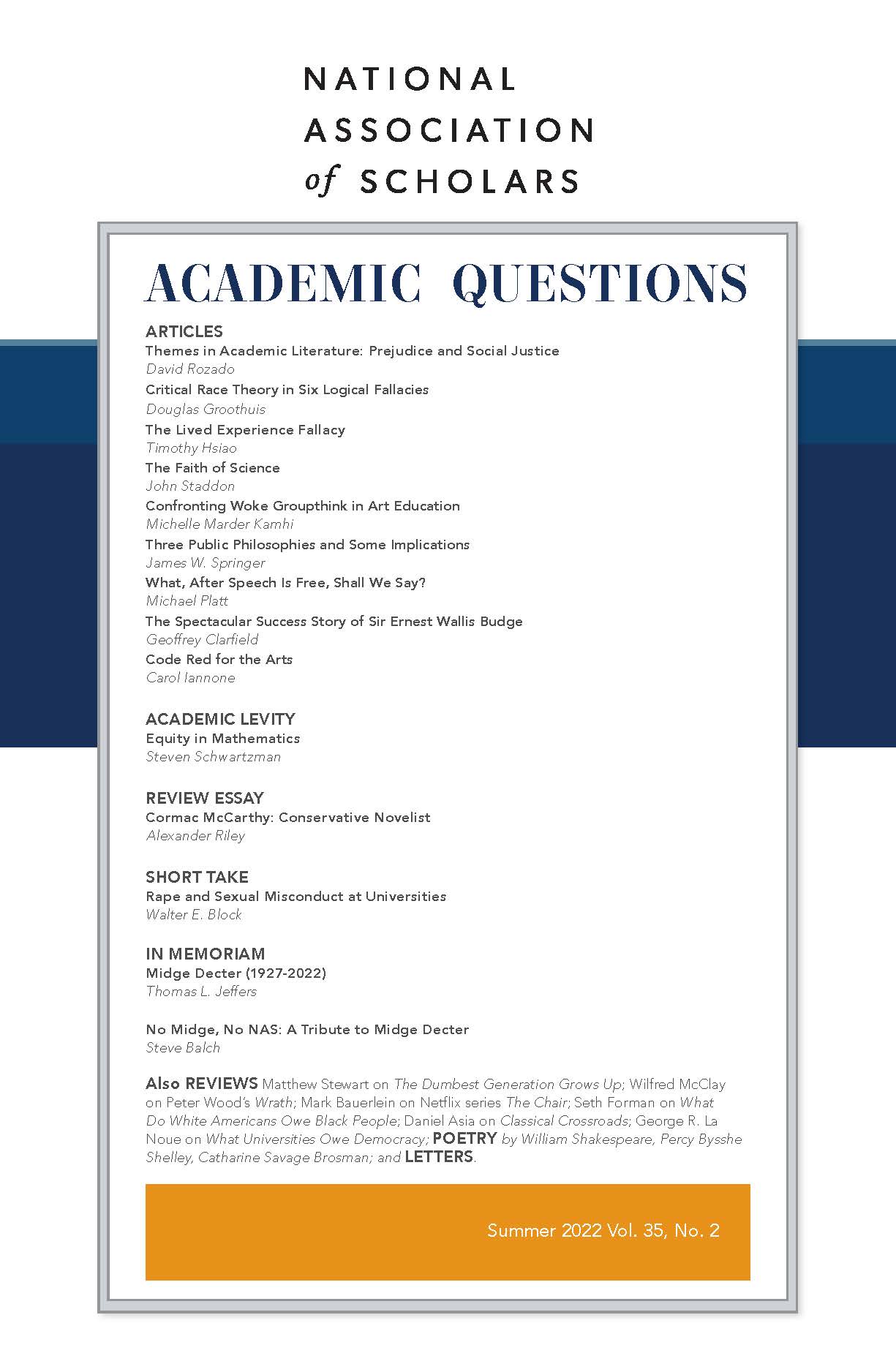Douglas Groothuis is Professor of Philosophy, Denver Seminary; [email protected]. He is the author of Walking through Twilight: A Wife's Illness—A Philosopher's Lament; Philosophy in Seven Sentences; Christian Apologetics: A Comprehensive Case for Biblical Faith, 2nd ed.; and Truth Decay: Defending Christianity Against the Challenges of Postmodernism.
Logic is the friend of the wise person, and illogic is a snare to all. We ought to follow the logic and evidence wherever it leads. On those issues that matter most—questions about God, humanity, meaning, morality, and society—we dispense with logic to our own peril. Illogic can damage individuals and entire societies, as Marxism has done repeatedly and worldwide. Illogic is damaging America as well through the acceptance of and application of Critical Race Theory (CRT), which has a penchant for fallacy production.
Some intellectual mistakes or fallacies are so commonly committed that they have been inducted into a canon of cognitive ignominy. Logical fallacies are divided into formal and informal fallacies. A formal fallacy is a blunder in a deductive argument, which invalidates the argument’s form. We will instead concentrate on informal fallacies, which deceive in various ways, often through the use of irrelevant information, false assumptions, or incorrect or misleading uses of evidence. Let me define CRT and inspect its cognitive corruptions.
CRT is a neo-Marxist theory that grew out of Critical Theory (spearheaded by Herbert Marcuse). It was augmented by Critical Legal Studies and focuses more on racial and gender categories than on economic exploitation. Racism is everywhere and every white person is part of a system of racism that oppresses people of color (but mostly blacks). This system as a whole must be taken down and replaced by one that ensures “equity” (proportional representation for people of color) through socialism.1 Now to the fallacies.
Begging the Question
Begging the question assumes a conclusion without giving an argument. It substitutes an assertion for a logical case. “I am against capital punishment because two wrongs don’t make a right,” begs the question, since it assumes that capital punishment is another wrong in addition to the wrong of murder. A real argument against capital punishment requires reasoning that leads to the conclusion.
CRT lends itself to begging the question because it claims that its critics are animated by false consciousness, white supremacy, white privilege, or some other moral or cognitive impairment. The CRT advocate believes that those who disagree with CRT are not just wrong in a few ways, but are systemically deceived. Marxism originally applied this idea to economic actors, but it is now applied on a racial and gender basis by CRT. The oppressors are deceived; the oppressed are in the know (standpoint epistemology).
If someone begs the question and foreswears any counterevidence, then the idea becomes unfalsifiable. This is irrational. Every challenge to one’s viewpoint can then be dismissed a priori. Proponents of CRT apply this idea to racism. White people are racists because they are part of systemic racism. No evidence to the contrary can exonerate them from this odious whiteness. When a claim is taken to be impervious to criticism, it loses rationality given its irrefutable dogmatism.
Things get worse when some CRT advocates claim that logic, critical thinking, appeals to standard logic, objective truth, objective evidence, normative grammar, and a linear approach to history and thinking in general are constitutive of the oppressor’s ideology. If so, they can be denied. This denial leaves nothing to rationally argue with or to rationally argue from. But those who negate logic, truth, evidence, grammar, and linearity, quickly jettison their negations when arguing for their cases, since these elements are required for sharable discourse. They thus contradict themselves and disqualify themselves from rational discussion.
Argumentum Ad Hominem
This means “argument against the man.” Instead of giving reasons against a position, those who hold the position are insulted as defective in some way that negates their view.
Of course, not all insults are fallacies. An insult can be justified by another’s actions. Or an insult may be given that is unattached to any further claim. Saying “You are an idiot” or “You are a fascist,” is true or false, but if it is unrelated to advancing another truth claim, there is no fallacy.
But, on the other hand, consider this indictment, “All who defend capitalism are racists.” Of course, this statement might be true; however, a rational case needs to be made for it. One would have to demonstrate that (1) one thinks that a free-market system will disadvantage blacks, and (2) that (1) is a good thing. This case is not easily made.
If a white person advocates for merit-based admissions for higher education, this can be rejected as whitesplaining (due to false consciousness), since it supposedly favors whites over blacks. Whitesplaining means expressing a view based entirely on one’s interests and privilege based on skin color. However, to advocate merit-based and race-neutral standards may have nothing to do with racism. It may simply be a color-blind endorsement of merit over race, whatever race benefits from it.
Consider sexual ethics. If you deem marriage to be a sacred and exclusive vow made between a man and a woman, this invites disparaging charges. You are homophobic, since you are against gay marriage. You are also a religious bigot if your view is based on any sacred text or tradition. If you do not support some aspect of transgenderism, then you are transphobic.
The use of the term phobic is derived from psychology which uses it to refer to an irrational and pathological fear, such as agoraphobia (the fear of open places) or hydrophobia (the fear of water). Phobias are anxiety disorders. If you are homophobic, you have an irrational fear of homosexuals, which is a disorder. The question of moral judgment does not come up.
The label of phobic in these cases goes further. We pity or feel compassion for those who suffer from hydrophobia, but we resent or judge anyone who discriminates unfairly. Thus, this ad hominem vilifies people as both sick and immoral.
Admittedly, many are afflicted with phobias that impair their rationality and ability to judge fairly on diverse matters. However, to judge someone as phobic and thus untrustworthy in their judgments simply because they disagree with your views on moral matters is to commit the ad hominem fallacy.
In an essay called “Bulverism,” C. S. Lewis exposed a new version of the ad hominem fallacy. Modern thinkers such as Freud and Marx have identified ways of discrediting ideas because they are “tainted at their source,” either psychologically or politically. “The Freudians have discovered that we exist as bundles of complexes. The Marxians have discovered that we exist as members of some economic class.”2 Ideas can be condemned and dismissed as stemming from psychological complexes or from one’s economic class biases and prejudices. For CRT, ideas can be dismissed and condemned because those in “the dominant culture” (white) hold them.
Bulverists are right that many ideas are “tainted at their source,” because of human prejudice, bias, turpitude, and other intellectual vices committed by our fallen race. However, if all ideas are tainted and thus unreliable, then CRT ideas are so affected. Thus, one could retort that, “You only say that because you are a Freudian.” We could substitute “Marxist” or “CRT advocate” or anything else.
The Freudian and the Marxian are in the same boat with all the rest of us, and cannot criticize us from outside. They have sawn off the branch they were sitting on. If, on the other hand, they say that the taint need not invalidate their thinking, then neither need it invalidate ours. In which case they have saved their own branch, but also saved ours along with it.3
To determine if a statement is true and reasonable, I need an argument to substantiate the claim. Everyone has biases and prejudices, but truth has neither biases nor prejudices, and finding truth through reason and evidence should be our goal. To Lewis again:
If you try to find out which [ideas] are tainted by speculating about the wishes of the thinkers, you are merely making a fool of yourself. You must first find out on purely logical grounds which of them do, in fact, break down as arguments. Afterwards, if you like, go on and discover the psychological causes of the error.4
False Dichotomy
False dichotomy is a commonly committed fallacy. It is positively pernicious in CRT. It limits the options to two when, in fact, there are more than two options.
In some cases, there is a radical either/or. A person is dead or alive, not both. There are true dichotomies and false dichotomies, and the latter ought to be avoided. A true dichotomy is a binary such as: a woman is either pregnant or not pregnant. She cannot be both at the same time. The options are mutually exclusive and jointly exhaustive (covering all the possibilities). There is no third option. In computer coding, everything reduces to 1s and 0s. But life is more than computer coding.
Our use of the either/or may be fallacious. We may split life up by oversimplifying the case and then generating false dichotomies. In a semi-drunken stupor, a fool might say, “Look, you are either a Democrat or a Republican.” This is a false dichotomy, since one might be a Libertarian or a Green Party member or something else.
The false dichotomy excludes genuine logical options, and this brings us to CRT. CRT assumes that if you do not accept CRT, then you think that racism is not a problem in America and would not want the history of slavery and Jim Crow to be taught in schools. This is a non sequitur, because it is a false dichotomy. There is a third option: teach the history without the ideology of CRT. One may reject CRT, and still believe racism is real, the disparities in black and white achievement need to be addressed (though perhaps not through socialism), and that America’s troubled racial history should be taught, pondered, and rejected. But consider yet another fallacy.
Hasty Generalization
It is easy to be intellectually impatient and reach a conclusion hastily and without enough evidence. We are prone to this error, especially in the age of mediated electronic images. The image may lead one to think that a phenomenon is common and widespread when, in fact, it is the image that is common and widespread, not the phenomenon itself. A visceral image of a protestor being hit by a policeman, accompanied by persuasive commentary, supports the idea that police brutality is common and that the police ought to be “defunded” or otherwise censured. Similarly, a montage of images of unarmed blacks being shot by white police officers raises the ire of many and lends credibility to claims of systemic racism.5
The adage that “a picture never lies” is false. It often lies when it is taken out of context and placed into a preset and ironclad narrative. If an innocent black man is wrongly killed or injured by the police, that is morally wrong and a fair trial should ensue. But there is more to be considered than merely a series of images, since so much can be left out, such as a violent resisting of arrest that occurred before the video images of the shooting. Getting the whole story about police violence against blacks requires hard statistics and social analysis about rates of violence and police policies.6 It is easier to react quickly than to reason carefully. If so, we commit the fallacy of hasty generalization.
The Use/Mention Fallacy
In our hypersensitive culture, one can get into deep trouble simply by speaking or writing a word or phrase deemed offensive. These terms are often epithets—words that sharply derogate others. However, one can mention an epithet without using it.
Consider a non-taboo epithet: Bill says, “John is a jerk.” Here, Bill uses the epithet “jerk.” That is, he is insulting John. Consider another case. Don says, “Bill said that ‘John is a jerk.’” Here Don is mentioning the use of “jerk” by Bill. Don is not using the word “jerk” to describe John. He is reporting what Bill said. If someone said, “Don called John a jerk,” he would be committing the use/mention fallacy in his error.
The stakes escalate quickly concerning racial epithets, such as the n-word. Neal A. Lester rightly says that the “word is inextricably linked with violence and brutality on black psyches and derogatory aspersions cast on black bodies.”7 Thus, no one should use the n-word as an epithet.
It used to be safe to mention an epithet if it was clear that one was not using it. By mentioning it you are, as it were, putting quotation marks around the offensive term or phrase. In conversation, this can be indicated by making the scare quotes gesture. One might say with the proper gesticulation, “In the film, ‘No Way Out,’ several characters call the lead character a (they then say the n-word with all its original letters).” I do not advise saying or writing out the n-word, even in this context, but this person is not using the n-word in the sense I described. He is mentioning it. To say that this person used the term is to commit the use/mention fallacy.
This is simple, but some people are obtuse. Inside Higher Ed reports that “Augsburg University in Minnesota suspended a professor for using the n-word during a class discussion about a James Baldwin book in which the word appeared—and for sharing essays on the history of the word with students who complained to him about it.”8 Professor Phillip Adamo was quoted in this piece as saying, “I see a distinction between use and mention. To use the word, to inflict pain or harm, is unacceptable. To mention the word, in a discussion of how the word is used, is necessary for honest discourse.”9 Adamo, who is white, asked one of his students to read a quote by the black writer James Baldwin from his essay The Fire Next Time (1963), which used the n-word. In discussion, he mentioned the word himself.
The offended students should have taken issue with Baldwin himself, since he, a black man, used the word. Instead, they went after the Professor, who merely mentioned the word. The university suspended the Professor for two terms. Such is the power of fallacies.
A Newcomer: The Cancellation Fallacy
We end our sad tour of logical fallacies with a new fallacy. This fallacy is a team effort, a collection of at least five fallacies packed into one. I call it the cancellation fallacy. It is so commonly heard and so egregious that it deserves analysis.
The phrase “cancel culture” popped up in 2020 after the death of George Floyd. Angry crowds felled and defaced statues of those deemed racist. Churches were vandalized. Some schools changed their names if their namesakes were deemed racist. Donald Trump and others have been deplatformed in social media purges. An entire platform, Parler, was removed from Apple and Google apps and effectively shut down. “Cancel culture” is an epidemic.
I will put the cancellation fallacy abstractly, since it helps us see its basic structure.
- Someone (especially a POC) is offended by P (any statement, person, object, process, or event).
- Therefore (i), P is wrong.
- The moral wrong committed by one who holds P is racism, homophobia, transphobia, or the like
- Therefore (ii), whoever affirms P must be cancelled.
- Unless others denounce P, (iii) they too must be cancelled, since “Silence is violence.”
The cancellation fallacy is a synergistic and strenuous effort. It is a high achievement of sophistry. But it suffers from at least five errors. First, it equates taking offense with a proper moral judgment. Emotional reactions may be proper or improper. Second, it commits the ad hominem fallacy (discussed above). If you offend me, you are a bad person, and bad people cannot give good arguments, which is false. Third, the supposed wrongness is placed into a broad condemning category, such as racism, and thus commits the straw man fallacy. It may offend you that I don’t want statues of Abraham Lincoln torn down, but that, in itself, does not make me a racist. Fourth, the threat of cancellation is a form of intimidation and means punishment if the threat is enacted. This commits the fallacy of argumentum ad baculum or “if you don’t agree with me, I will hurt you. Therefore, agree with me.” Today, this translates as: “Those critical of Critical Race Theory will be cancelled, which means losing your book contract, your employment, your social status, and more.” Fifth, to claim that if I do not oppose P, then I must endorse P, commits the fallacy of the argument from silence. Not saying anything (“silence”) cannot, in itself, be used to indict someone.
Fallacies Be Gone!
Fallacies are the bane of critical thinking. They trick us by their perennial cunning into holding false beliefs because of unsound reasoning and inadequate evidence. Anyone may be subject to deceitfulness, so we should be alert and alert others to these cognitive dangers, especially on matters as consequential as Critical Race Theory, which has a peculiar talent for racking up logical fallacies and even inventing a new one.
1 See Douglas R. Groothuis, Fire in the Streets (Washington, DC: Salem Books, 2022).
2 C. S. Lewis, God in the Dock, Kindle Edition (HarperOne, 1970), 271.
3 Ibid., 272.
4 Ibid., 273.
5 For a thorough account of recent claims of racist violence against blacks, see David Horowitz, I Can’t Breathe: How a Racial Hoax is Killing America (Washington DC: Regnery, 2021).
6 See Heather Mac Donald, The War on Cops (New York: Encounter Books, 2017).
7 Sean Price, “Straight Talk about the N-Word,” Teaching Tolerance Magazine 40 (Fall 2011).
8Colleen Flaherty, “Too Taboo for Class?,” Inside Higher Ed (February 1, 2019).
9 Ibid.
Image: Kalea Morgan, Public Domain













